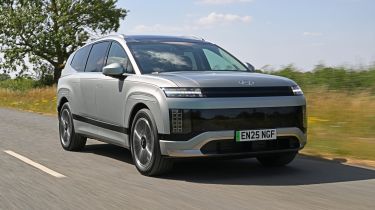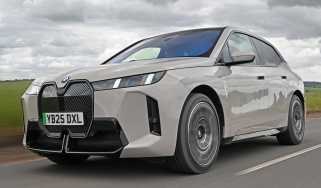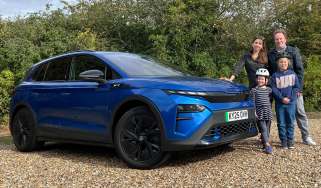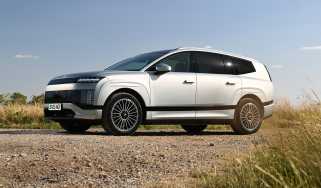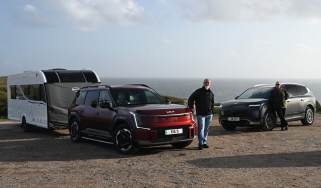New Hyundai Ioniq 9 2025 review: is the brand’s biggest SUV one of its best?
We hit UK road in the biggest, most luxurious Hyundai SUV ever

Verdict
The Ioniq 9 gets most of the premium electric SUV character traits right, with a long list of kit, plush seats and plenty of passenger space. But in top-spec Calligraphy trim it doesn’t quite hit the mark, courtesy of an overly firm ride that takes the edge off a package that should be all about comfort.
There’s no issue with the quality inside, which arguably matches premium brand Genesis in places. The tech is user-friendly, albeit with a few irritations, and there are plenty of practical touches, too. If the related Kia EV9 is anything to go by, Hyundai shouldn’t have much trouble finding buyers.
The pursuit of premium is something that even the most mainstream manufacturers are engaged in these days, and the Hyundai Ioniq 9 aims to deliver the ultimate in luxury as the company’s new flagship electric SUV. It’s a seven-seater as standard, or a spacious six-seater as an option, with a big battery for a long driving range. Hyundai has piled on the standard kit to make occupants feel pampered and relaxed on every journey.
If the concept of a large Korean electric luxury SUV sounds familiar, it’s a template that has already been followed by the Kia EV9. The Ioniq 9 uses the same E-GMP platform as that car, as well as Hyundai’s other electric Ioniq models. But while the EV9 has a hard-edged element to its design, the Ioniq 9 is more sculpted, courtesy of Hyundai’s ‘Aerosthetic’ design concept.
At five-metres long it’s still a vast SUV, but the rounded nose, tapering window line and narrow glass area over blistered wheelarches mean that the Ioniq 9 carries a distinctive look when compared with Kia’s biggest model. These features are combined with aerodynamic tweaks that help the Ioniq 9 return a drag coefficient of 0.259Cd when digital door mirrors are fitted (it’s 0.269Cd with standard glass mirrors). As with Hyundai’s other Ioniq models, the 9 doesn’t follow a set template, so it looks unique when compared with the Ioniq 5 and Ioniq 6, although the pixel-style lighting front and rear does offer a connection between all three models.
Inside, the cabin is truly vast, as you would expect from such a large SUV. There’s acres of space on offer up front and behind, while the third row is big enough for two adults – the difficult part is climbing on board.
There’s a slightly curved twin-screen dashboard with a climate control panel lower down on the centre console, and these will be familiar to anyone that has driven a modern Hyundai. It’s one of the areas where we’d like to have seen a bit more flair, but it does mean it’s a pretty user-friendly interface to use.
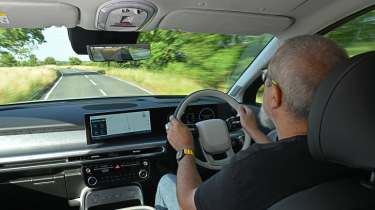
The top-spec Calligraphy model comes with all the kit you could imagine and a lot more besides. There are heated and ventilated seats front and rear, a 14-speaker Bose sound system, panoramic glass, Nappa leather upholstery and a special storage compartment at the bottom of the centre console that uses UV rays to sanitise small items such as phones and keys.
The six-seat configuration is exclusive to this top-spec trim, and adds captain’s chairs to the middle row that can rotate through 180 degrees to create an executive-style lounge, where passengers in the back sit face-to-face. There’s also the ability to turn them 90 degrees to face the wide-opening rear doors, which make fitting child seats a doddle.
Hyundai quotes a cargo capacity of up to 1,323 litres with the rearmost seats folded, presumably measured to the roof. While it doesn't offer a number with rows two and three tucked away, industry data experts CAP offers a figure of 2,419 litres – beating every one of the Ioniq 9's main rivals. In seven-seat cars everything folds automatically, but the two sliding seats for the six-seater flip forward electrically, while the rest of the controls are manual.
The powered tailgate opens to reveal a surprisingly small opening – a side effect of the tapered shape of the car’s bodywork – which will make loading large items trickier than you might expect. One plus point is the Ioniq 9’s extra storage under the bonnet. This ‘frunk’ measures 88 litres in the RWD model and 52 litres in the AWD versions, and is big enough for a charging cable and some extra bits and pieces.
Power outputs range from 215bhp for the Premium rear-wheel-drive model through 227bhp for the mid-range four-wheel drive machine and up to 421bhp for the Performance powertrain driven here. All cars come with a 110kWh battery, while the best range is delivered by the base model at a claimed 385 miles, although the rest of the line-up still manages more than 370 miles under test conditions.
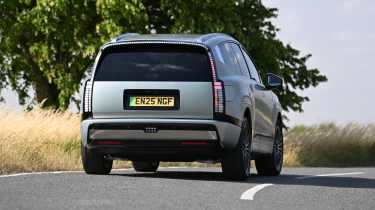
During our brief first UK drive of the Ioniq 9, we managed a return of 2.7 miles per kWh. That included some energy-sapping motorway work, but is close to the official figure of 3.0mi/kWh.
As with Hyundai’s other Ioniq models, rapid charging tech means that while the battery is big, a 350kW DC source can take the pack from 10-80 per cent capacity in 24 minutes. In contrast, a charge from a domestic three-pin plug socket would take almost two days…
Another carryover from Ioniqs 5 and 6 is vehicle-to-load capability, so that you can power accessories from the car’s drive battery or even send power back to the grid. In addition to this, two of the six USB-C sockets in the cabin have the ability to charge at 100 watts directly from the drive battery. This means that larger items such as laptops can be charged without having to use a mains lead, although you do need a thicker high-voltage power cable to take advantage of this.
While upmarket brands such as Land Rover and Mercedes equip their highest-spec models with air suspension, the Ioniq 9 features a more conventional set-up with a MacPherson multi-link front end and a full multi-link set-up at the back. However, it’s also equipped with self-levelling dampers and hydroelastic bushings to enhance the smooth ride.
On the road, the soft edge to the suspension is present, although the large 21-inch wheels that come with Calligraphy trim undo some of that comfort, because they introduce a fidget to the ride where the Ioniq 9 can become quite unsettled over uneven surfaces. It’s an underlying aspect of the car that never really fades away at any speed, which is a shame because in most situations this is a vehicle that should deliver a smooth ride.
This focus on comfort comes at the expense of handling, but since the Ioniq 9 is such a big, heavy machine, it’s not a natural when it comes to hustling down a twisty B-road. The steering lacks feedback, while body roll in corners will be the biggest limiting factor as to how hard you choose to drive.
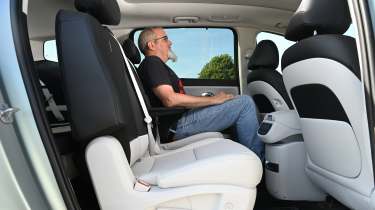
There are four drive modes, but since the suspension remains the same in each setting, it’s the throttle response that offers the biggest changes to the car’s character. In Normal and Sport modes, there are instant reflexes that make the most powerful model’s claimed 0-62mph time of 4.9 seconds seem entirely feasible. The multifunction seats lower the base and firm up the bolsters when Sport mode is chosen to create more of a sports seat that holds you in place when cornering.
However, another trait of these modes is a throttle pedal that offers responses that are slightly too sharp at the top of its travel. Small applications see the car jerk forwards as the power comes in, while lifting off to cut the power sees a similar movement in the opposite direction, and this is exacerbated by the car’s soft suspension set-up. This isn’t too much of an issue when driving solo, but if you have passengers that are prone to motion sickness, it might be better to select Eco mode, which rounds off the throttle response to make it smoother while boosting efficiency at the same time.
The cabin is mostly quiet – helped by acoustic glass, triple door seals and noise cancelling speaker tech – but this means that a gentle rustle from the door mirrors can be heard at motorway speeds. The mirrors themselves aren’t the biggest, so rearward visibility is a little compromised. Still, there’s plenty of driver-assistance tech on board to compensate, with self steering, lane-keeping assist and automatic lane changing, adaptive cruise control and Hyundai’s familiar rear-facing lane-change cameras, too.
In fact, the Ioniq 9 follows a path that every new Hyundai has taken, with a number of beeps and bongs from the assorted safety systems to keep you on the road. The over-speed warning can be silenced via a long press of the mute button on the steering wheel, but harder to deactivate is the distracted driving warning. A small sensor on top of the steering column detects when your eyes are not on the road, but much like other Hyundai’s we’ve tried with this system, it’s hyper sensitive, and will even alert you if you're looking across a T-junction or at the main touchscreen, for example. It’s quite frustrating.
Overall, the Ioniq 9 is a distinctive looking large SUV that offers plenty of space, reasonable comfort and a long list of standard kit. Prices are still under wraps, but are expected to be in a similar range to the EV9’s, starting from around £65,000, with the top-spec Calligraphy model tested here coming in at less than £80k. In the UK we’ll only get the higher grade Premium, Ultimate and Calligraphy trims, too, further cementing the Ioniq 9’s position as a large luxury family SUV.
| Model: | Hyundai Ioniq 9 110kWh Calligraphy 6 Seat |
| Price: | £80,000 (est) |
| Powertrain: | 110kWh battery, 2x electric motors |
| Power/torque: | 421bhp/700Nm |
| Transmission: | Single-speed automatic, four-wheel drive |
| 0-62mph: | 4.9 seconds |
| WLTP consumption: | 3.0mi/kWh |
| Range: | 372 miles |
| Size (L/W/H): | 5,060/1,980/1,790mm |
| On sale: | September |
Now you can buy a car through our network of top dealers around the UK. Search for the latest deals…
Deals on Hyundai Ioniq 9's key rivals

